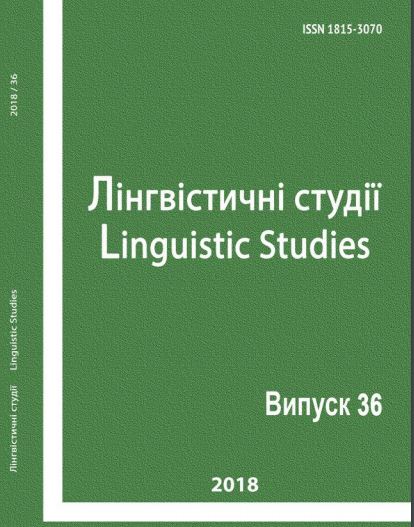Anthropological Dimension of National and Cultural Context in John Keat’s Poetry: the Dialogue between Poet and Motherland.
DOI:
https://doi.org/10.31558/1815-3070.2018.36.13Klíčová slova:
John Keats, English literature, Romanticism, poetics, literary conceptAbstrakt
Poetic actualization of nationally specific concepts in Keats’s poetry is anthropocentric in its nature. Keats poetic conceptualization discloses itself as a reflection of creative and cognitive activity of a poetic personality, directed towards representation of the national environment in the system of multilevel senses that fix poly cultural experience of the nation aggregated in the literary universe of different epochs and ethnos. The anthropocentric nature of national space poetic representation consists in the interrelations of the elements belonging to three basic semantic domens: “the poet” as the preserver of invaluable ethnically specific and universal knowledge; “myth” – mythologeme, association, allusion representing the dialectics of the cultural evolution of the nation, the most typical impressions and stereotypes in the structure and forms of literary consciousness; “nature” – inspired physical substance of the being existing in its primary forms of human and social adaptation to geographic environment, forms of cultural and artistic experiences.Reference
Barnard, John. "Charles Cowden Clarke's 'Cockney' Commonplace Book." Keats and History. Edited by Nicholas Roe. Cambridge: Cambridge University Press. 1995. 65-87. Print.
Bart R. “Smert' avtora (The death of the author)” Izbrannye raboty (Selected works). Moscow. 1994: 384-391. Print.
Bieliy A. Kritika: Estetika: Teoriya simolisma (Criticism: Aesthetics: Theory of symbolism). Moscow: Respublika. 1994. Vol.2. Print.
Bromwich David. “Keats's Radicalism” Studies in Romanticism.Vol. 25, No. 2 (Summer, 1986): 197-210. Published by: Boston University.: http://www.jstor.org/stable/25600592. Web. 12 June, 2014.
The Cambridge Companion to Keats. Ed. By Susan J. Wolfson. Cambridge: Cambridge university Press. 2001. Print.
The Challenge of Keats. Bicentenary Essays, 1795-1995. Ed. by. Allan C. Christensen. Amsterdam – Atlanta: Rodopi GA, 2000. Print.
Diakonova N. Angliyskiy romantism: Problemy estetiki (English Romanticism: Problems of aesthetics). Moscow: Nauka, 1978. Print.
Diakonova N. Keats i yego sovremenniki (Keats and his contemporaries). Moscow: Nauka. 1973. Print.
Fermanis, Porscha. John Keats and the Ideas of the Enlightenment. Edinburgh University Press. 2009. Print.
Gadamer G.-G. Aktualnost prekrasnogo (Actuality of the beautiful). Moskow: Iskusstvo. 1994.
Gadamer G.-G. Philosophia i literatura (Philosophy and literature). Moskow: Iskusstvo. 1991. Print.
Hartman, Geoffrey. “Romanticism and Anti-Self Consciousness” Beyond Formalism: Literary Essays, 1958- 1970. New Haven (Ct.), L.: Yale UP. 1970. Print.
Hartop, Christopher. The Classical Ideal: English Silver, 1760–1840. Cambridge: John Adamson. 2010. Print.
Haverkamp, A. “Mourning Becomes Melancholia - A Muse Deconstructed: Keats's Ode on Melancholy” II New Literary History. Charlottesville. (1990). Vol.21. №3: 693-706. Print.
Levinson, Marjorie. Keats's Life of Allegory: The Origins of a Style. Oxford: Basil Blackwell. 1988. Print.
Mugglestone, Lynda. "The Fallacy of the Cockney Rhyme: From Keats and Earlier to Auden." The Review of English Studies 42, No. 165 (February 1991): 57-66. Print.
Nagar A., Prasad A.N. Recritiquing John Keats. New Delhi: Sarup &Sons, 2005. Print.
Pavlychko S. Teoretychniy dyskurs ukrainskogo modernism (Theoretical discourse of Ukrainian modernism). Diss. Kyiv. 1995. Print.
Roe N. Keats and the Culture of Dissent. Oxford: Clarendon Press. 1997. Print.
Rzepka, Charles J. The Self As Mind: Vision and Identity in Wordsworth, Coleridge and Keats. Cambridge (Mass.), L.: Harvard UP. 1986. Print.
Sandy, Mark. Poetics of Self and Form in Keats and Shelley: Nietzschean Subjectivity and Genre. Ashgate, 2005. Print.
Tolmachov V. “Neoromantism” (Neoromanticism)”. Literaturnaya encyclopedia terminov i poniatiy (Literary encyclopedia of terms and notions). Ed. By A. Nikoliukin. Moscow: Intelvak. 2001. Print.
Ulmer, William A. John Keats. Reimagining History. Palgrave Macmillan. 2017. Print. Urnov M. Na rubiezhe veikov (On the turn of the centuries). Moscow: Nauka. 1970. Print.
Victorian Keats and Romantic Carlyle: The Fusions and Confusions of Literary. Ed. by C. C. Barfoot. Amsterdam – Atlanta: Rodopi GA, 1999. Print.
Vitkovskiy E. “Voshod Endimiona (The rise of Endymion)” John Keats. Stihotvoreniya (Poems). Moscow: Ripol classic. 1998. Print.
White, Keith D. John Keats and the Loss of Romantic Innocence. Amsterdam – Atlanta: Rodopi GA,1996. Print.
Wu, D. “Keats and the “Cockney School”. The Cambridge Companion to Keats S. Wolfson (Ed.). Cambridge: Cambridge University Press. 37-55. Print.
Yelistratova A. A. Naslediye angliyskogo romantisma (The Legacy Of English Romanticism). Moscow: Akademia nauk SSSR. 1960. Print.


